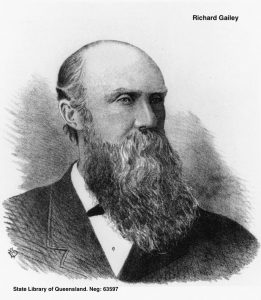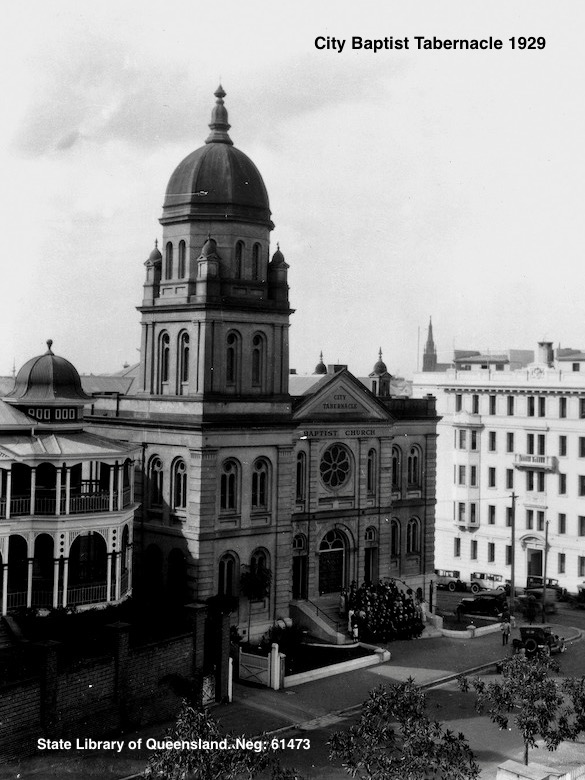Richard Gailey, colonial architect (1834 – 1924) 
In discussions about colonial architecture in Brisbane the name Richard Gailey stands out. He is generally described as ‘important, renowned, influential, prolific’.
So, who was Richard Gailey?
He was born in Donegal, Ireland in 1834. He qualified as an architect and practised in Londonderry. In 1864, at the age of 30, he emigrated to Melbourne on the advice of the father of Sir George Bowen, first Governor of Queensland, and then moved to Brisbane. His timing was perfect as the new colony was soon to experience an economic and building boom and there were not many skilled professionals in Brisbane at the time. It was the start of a long and successful career for the astute and hard-working Irishman who relished the opportunity to use his architectural and entrepreneurial skills to benefit both himself and his newly-adopted country.

It wasn’t long before he established his own practice. After being appointed licensing surveyor under the Real Property Act, his public and private business took him all over Queensland. He surveyed and laid out the town of Bowen and was involved in the design of many buildings in Toowoomba and other parts of the Darling Downs.

In Brisbane, the Courier Building became a typical example of his architectural and construction skills, and he set up his own offices in the building. The beauty and quality of his designs ensured that he was always in high demand.

Over the years he designed an amazing number of buildings including over thirty hotels as well as many commercial, residential, religious and educational properties. Buildings such as the Courier Building (1885), the Regatta Hotel (1886), Kangaroo Point Hotel (1886), Brisbane Girls Grammar (1875), City Baptist Tabernacle (1890), Moorlands (1892), among others, are all a lasting legacy of his talent.



He became a trusted valuator of building societies, promoter of the Brisbane Permanent Building and Banking Co. and supporter of the Royal National Society and Royal Geographic Society. He bought a one third share in the Brisbane Newspaper Co Ltd. and remained as shareholder and director until the company reconstruction in 1894. He then retired from his business interests to focus solely on his profession as an architect.


On a personal level he was just as committed, successful and highly regarded. In 1868 he married an Irish girl Minnie (Mary) Rice and they had three sons and two daughters. A major passion was the Masonic Organisation. After being admitted as a Freemason in 1886 he soon took on a prominent role in the administration and promotion of the Masonic movement, serving on several committees and providing support for many years. In 1902 he was presented with a portrait of him in full regalia painted by Oscar Friatrom in recognition of his long and dedicated service. The portrait now hangs in the Toowong Masonic Lodge.
A major passion was the Masonic Organisation. After being admitted as a Freemason in 1886 he soon took on a prominent role in the administration and promotion of the Masonic movement, serving on several committees and providing support for many years. In 1902 he was presented with a portrait of him in full regalia painted by Oscar Friatrom in recognition of his long and dedicated service. The portrait now hangs in the Toowong Masonic Lodge.
As alderman for the North Ward of the Municipal Council from 1901-1904 he worked hard in the interests of improving the quality of life for local communities. He was also President of the North Brisbane School of Arts for a time, promoting the value of the arts and sciences.
Richard Gailey never stopped working, even after his son Richard Gailey jr, joined him in the business in the early 1890s. He was healthy and worked up to a few days before his death on 24 April 1924, just two days after his 90th birthday. He is buried in Cleveland Cemetery, Brisbane with his wife who had pre-deceased him by a few years. Brisbane had lost ‘the doyen of Brisbane architects’ (Queenslander 3 May 1924) and a highly respected pioneer of the city. Gailey Road, Taringa, is named in his honour as he had owned a lot of property in the area.
